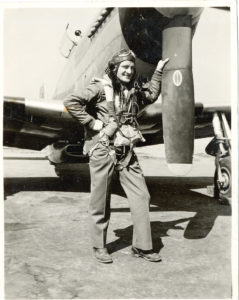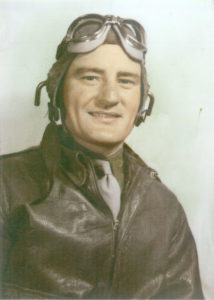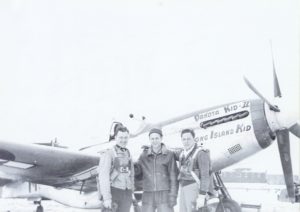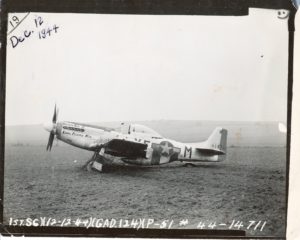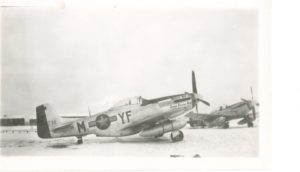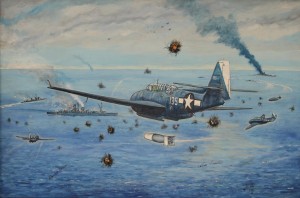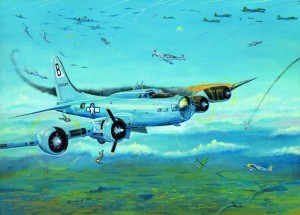Raymond G. Wicklander was born in 1921, in a log home seven miles east of Washburn, ND, on his grandpa’s homestead.
Ray graduated from the Washburn High School in 1938 and went to college that fall in Minot for basic courses in engineering .
The next fall, Ray went to the Agricultural College in Fargo for mechanical engineering. While in Fargo, Ray got the opportunity to learn to fly through the civilian pilot program.
When Ray came home that summer, a neighbor had purchased a Curtis pusher airplane but was afraid to fly it. Ray was told he could fly it as much as he wanted and he spent many enjoyable hours flying that pusher plane around the Washburn area. One time he was giving a friend a ride when the three cylinder engine blew out a spark plug. The plane lost power and lost altitude. Ray quickly found a place to land and set the plane down. They put in a new spark plug and started the engine again. Problem was there was not a lot of room for a takeoff run. They were in a small pasture but Ray figured they could get airborne before they reached the fence. Ray told his apprehensive friend to get in the plane and Ray revved it up. They got off the ground before they reached the fence but caught the tail on the top wire. They were slammed down on the other side but then bounced back in the air again. The rest of the flight was uneventful, but for some reason Ray’s friend never wanted to fly with him again. (This plane still exists, it is owned by a collector in Oregon.)
In July of 1941 Ray decided to join the Navy to be an aviator. Ray was told he would be able to finish his last years of college before he would be called up. Pearl Harbor was bombed on December 7, 1941. Ray was home for Christmas vacation when the call came to report to duty. He would not be finishing college but found himself excited about the change of events.
In January, Ray took the train down to Minneapolis to start his training but with all the new recruits coming in they were full. Ray then got on the train with some other recruits and went all the way to New Orleans on Lake Pontchartrain to begin Navy basic training. The weather was beautiful and Ray felt pretty lucky not to be training in Minnesota during the winter.
After several months of basic, Ray began flight training. The first trainer Ray flew was the “Yellow Peril”, a yellow biplane Navy trainer. The base on Lake Pontchartrain was very muddy and the taxi ways were covered with planks. If you got a wheel off the planks you were instantly stuck.
Next, Ray went to Pensacola, Florida. At Pensacola, on one end of the runway, off base, someone owned an elephant. It was said that for the instructor to pass you, the elephant had to have its tail up as you took off, if his tail was down, you failed.
Then he was sent to Miami where he received his wings as a Navy ensign. Here Ray flew the Brewster Buffalo, the small, underpowered, portly, Navy fighter that was found no match for the Japanese Zero. The landing gear had to be cranked up and down by hand. It had been relegated to training only. Ray practiced take-offs and landings on a circular air field with instructions from a landing signal officer to prepare for carrier operations.
From here, Ray went to Chicago. A coal-burning paddle wheel passenger ship had been converted into a training carrier called the Wolverine. Passenger cabins were stripped off and a 500 foot flight deck built on top of the hull that sailed on Lake Michigan. Ray practiced carrier operations with the SNJ North American Texan equipped with a tail hook. The training of carrier pilots on Lake Michigan early in the war was necessary as both coasts were susceptible to submarine attacks from the Japanese and the Germans.
Ray was able to go home on leave for two weeks, married his sweetheart and had a short honeymoon.
Ray then reported for duty at San Diego where he started flying the Douglas SBD Dauntless Dive-bomber. The Dauntless carried a crew of 2, pilot and radio gunner. It carried an external bomb load and two forward firing 50 cal. machine guns, the radio gunner had a twin 30 cal. in the rear cockpit. After a short period of training he was assigned to VB-26 (dive bombing squadron) of Air Group 26, which consisted of 3 squadrons, F4F Wildcats, TBF Avengers, SBD Dauntless’.
AG 26 personnel and planes were loaded on a jeep carrier to head for Hawaii. As luck would have it, the jeep carrier was so full, that some got to go to Hawaii on the cruise ship Matsonia with a bunch of college girls that had been stranded in the states since the bombing of Pearl Harbor. Ray was one of the few who was able to make the trip on the cruise ship. Ray lived like a king, food was great and he had the finest of accommodations. Ray figured this Navy life couldn’t be beat! And all those nice college gals!! Ray met Mrs. Dagmar Cooke on the ship. She was from the famous Cooke family in Hawaii. When Ray got to Maui,Hawaii, he and the other officers that had been on the Matsonia were invited to the Cooke mansion for a party. After a good time at the party, Ray and another fellow who was also married decided to go back to base and let the single guys do all the dancing. They didn’t have any transportation but thought they could catch a ride with someone. While they were waiting outside the mansion, a limousine drove up with Dagmar’s widowed mother-in-law and none other than Admiral Nimitz, Commander and Chief of the Pacific Fleet. Admiral Nimitz had escorted Mrs. Cooke out for dinner and was bringing her back. Nimitz asked, “You boys need a ride back to base”. “Yes sir, we sure would”, said Ray. Ray and the other fellow rode back with Nimitz and had a nice visit on the way although the conversation was thoroughly laced with “yes sirs” and “no sirs”.
Based at Wailuku, Maui, Ray trained with the Dauntless until finally they were loaded on the jeep carrier, Long Island, and headed with orders for Guadalcanal. The Marines had a bunch of watch dogs contained in kennels for the trip. These kennels were on the deck. By the time they had reached their destination the dogs were all out of the kennels roaming the deck and the kennels were stashed with booze! They first went to Efate and unloaded the Marines, dogs and the booze still in the kennels. The Long Island then went up to Guadalcanal where Ray and VB-26 were based off Henderson field.
There were still some Japanese on Guadalcanal but there was not much trouble with them other than a sniper now and then. Japanese bombers would occasionally fly in from Bougainville at night on harassment raids to drop a bomb or two. Ray started flying raids against the Japanese and attacked Munda air field several times, even though there wasn’t much left there to bomb except for some entrenched soldiers and antiaircraft guns. One memorable mission was a 600 mile flight up to Bougainville with drop tanks. Ray’s skipper, Smiling Bob Beebe, couldn’t drop his wing tanks when they were empty and had to turn back. When they got to Bougainville, Ray dived on a merchant ship anchored in the bay when a Zero got on his tail. Luckily a VF26 F4F Wildcat shot him down before he could shoot up Ray’s Dauntless.
Ray spent most of 1943 at Guadalcanal flying missions against islands in the area. Finally, Ray was sent back to the states on a transport and didn’t get much to eat during the trip. Ray, as an officer, got 2 meals a day that consisted of a small helping of reconstituted scrambled eggs and two slices of bread. The poor Marine soldiers on the ship only got one meal a day. The Merchant Marine crew of the ship ate like kings. Garbage was placed on the fan tail every evening to be dumped after dark. The poor Marines would go through the garbage to try to find something to eat every evening. Finally, the transport got to San Francisco.
Ray received several weeks of leave and caught the train home. Early in 1944, Ray reported to a Navy base in San Diego and was assigned to VB-19 in Air Group 19 as a Junior Grade Lt.
Ray started flying the new Navy dive bomber, the Curtis SB2C Helldiver. The Dauntless was too slow and the wings didn’t fold for storage on the carrier. The Helldiver was a bigger and heavier plane than the Dauntless and took some getting used to. The first Helldiver (SB2C-1) was underpowered and the pilots didn’t like them but later versions (SB2C-3) had a bigger engine and performed much better. The Helldiver also carried a crew of two, pilot and radio-gunner. It had an internal bomb bay and two forward firing 20mm cannon in the wings. It also had the twin 30 cal. in the rear seat. Air Group 19 consisted of three squadrons, F6F Hellcats, TBM Avengers, and the Helldivers.
Late in February of 1944 AG 19 boarded the Lexington and departed for Hawaii. After arriving in Maui, Ray and the rest of AG 19 conducted training missions for the next several months. Training for Ray consisted of dive bombing, glide bombing, navigation and gunnery practice. They also trained in night operations.
Ray got his first full time gunner-radioman, Jerry Warnke. Up to this point, and while Ray was with AG-26, the radio gunners would fly with different pilots for every mission.
In June of 1944, AG-19 conducted refresher carrier operations from the USS Franklin. Later that month AG-19 boarded the USS Intrepid for transportation to Eniwetok. The Intrepid arrived at Eniwetok the last of June and the first of July AG-19 transferred to the USS Bunker Hill to practice carrier operations.
By July 10, 1944, AG-19 was permanently stationed on the Lexington and conducted its first combat missions against Guam. The last of July, strikes were conducted against Palau.
Aboard the Lexington was Admiral Marc A. Mitscher, commander of the Fast Carrier Task Force, the Lexington served as his flagship. When they first got on the Lexington one of Ray’s squadron mates, Lt. Wallace Griffin, was walking around the ship just taking things in. He found himself on the carrier island near the bridge on one of the observation decks high above the landing deck. There was an older fellow sitting up there wearing a baseball cap and a khaki uniform with no rank. Wallace took him for a reporter and started causally visiting with him about the wonderful view they had up there. Wallace was mortified to later learn that he in fact had been visiting with Admiral Mitscher himself!! The rest of the squadron forever after gave Wallace a bad time about being buddies with the Admiral.
During the first part of August, strikes were conducted against Bonins, Kazans and Iwa Jima.
The last of August was spent rearming and re-supplying at Eniwetok.
September was spent flying strikes against Peleliu and the Philippines. During this time Ray and his gunner, Jerry, flew many strikes against Japanese ships and ground targets. Most missions, Lt. Ray Wicklander flew right wing in a 3 plane formation led by VB-19 Skipper, Lt. D. Banker. Left wing was flown by Lt. Bill Emerson.
In late August, Emerson was hit during a mission and had to ditch in the ocean. Emerson and his gunner were rescued by the submarine, USS Shark and were with them for about a month until early October. The USS Shark was reported lost with all hands on Oct. 24, 1944. The Shark was never found and bodies of the crew never recovered. Japanese records, after the war, suggest the Shark may have been depth charged by a destroyer east of the Philippines.
On one mission, Ray dived on a Japanese transport ship and his bomb did not release. The other planes in the formation dropped their bombs, hit the ship and sank it. On the way back, Ray asked for permission to use his bomb against a Japanese radio station on the south east side of the island of Formosa. Ray obtained what was described as a beautiful direct hit, which went through the roof of the building and destroyed it.
On Sept. 13, 1944, early morning just before sunrise, Ray was in his plane with the engine running awaiting take off when they were ordered to cut engines and things were deathly quiet. A plane was heard approaching the carrier in the dark, flying low over the water. Every one held their breaths as the engine noise of the plane got louder and closer. At the last moment the plane pulled up and over the Lexington, at the same moment releasing its bomb which passed over the carrier and exploded in the water on the other side. Ray saw the red “meat ball” on the underside of the wing as the plane went over. If that bomb had landed amongst all the planes sitting on the deck full of bombs and fuel, it would have been a disaster with much loss of life and perhaps the loss of the Lexington itself. After several minutes, engine startup was again ordered and after takeoff, Ray flew a strike against a Japanese airfield on Negros Island. Ray dived on a concentration of 7 Japanese planes and destroyed or damaged all of them.
One mission, in October, after Bill Emerson and his gunner returned to the Lexington, Ray, Banker and Emerson dived on the main power plant at Lake Jitsugetsutan, Formosa. Hits were obtained on the main power building and covered the plant with smoke and debris. Another mission destroyed the main dock facilities at Iloilo city harbor in the western Philippines.
One incident where Ray was to bomb some oil tanks at Cebu City in the Philippines, he was flying a Helldiver that just had a wing replaced. The left wing was heavy and couldn’t be corrected with the trim tab. Ray had to hold the stick over to the right to keep the plane level. After pushing over in his dive on the target he went into a spin, pulled out and tried it again. Spun out again! Ray dropped his bomb in a glide and went back to the Lexington. They found out the trim tab cables had been crossed when the wing was changed.
Early October the Lexington went to Ulithi to rearm and resupply. Ray visited the famous Mog Mog island, was given two cans of warm beer and was told to have “a good time”.
In October of 1944, the largest sea-air battle ever, occurred in and around the Philippines. The Japanese Navy planned an all-out assault against the American fleet. The northern Japanese force had the last four surviving aircraft carriers. The central force consisted of battleships (including the largest battleships that ever sailed, the Yamato and Musashi), cruisers and destroyers. The southern force had the rest of the Japanese naval forces, battle ships, cruisers, destroyers.
On October 24, 1944, Ray along with Lt. Banker and Lt. Emerson were sent on a search mission near Luzon with a cover of Hellcat fighters. They found the Japanese cruiser, Nachi, in Manila Bay. Banker decided to try a glide attack on the Nachi but it sent up such a curtain of antiaircraft fire that they left it alone and continued their search for the main fleet. The only thing they found in the rest of their search were two small Japanese freighters anchored near Mariveles at Bataan. They glide-bombed the freighters and succeeded in sinking one of them while receiving some antiaircraft fire from Corregidor. When they returned to the Lexington, Ray saw the USS Princeton fiercely burning and putting up a column of black smoke. Japanese planes had attacked the American carriers. The carrier USS Princeton was hit with a bomb and ended up being lost.
Strikes from the Lexington and other carriers hit the central Japanese force. The battle ship Musashi was sunk and the Yamato was damaged and many air battles ensued. Air Group 19 shot down 60 enemy planes, most being credited to the Hellcat fighters . The bomber squadron alone brought down nine planes which was pretty good for a big heavy dive bomber that had the maneuverability of a dump truck!
One of the pilots in Ray’s squadron, Lt. Stu Crapser and his gunner Jim Barns were on a search mission several hundred miles north of the American carrier fleet. Late on the 24th they caught sight of the Japanese carriers. Barns radioed the position of the carriers back to the fleet, then Crasper, knowing it was too late to launch a strike from the fleet, decided to take on one of the carriers all by himself. Crapser dived on a carrier and in turn was attacked by Zeros. Barns did his best keeping the fighters off their tail and shot one down. Crapser and Barns were able to get back, but just barely. Their plane was heavily battle damaged.
Early on the morning of Oct. 25th, 06:30 hours, Air Group 19 launched against the Japanese carrier force that was found about 100 miles north of the fleet. Ray along with Banker and Emerson dived on the carrier Zuikaku and got hits on the flight deck. These hits were followed by 14 more dive bombers with at least 8 more hits. Immediately after the strike, the Zuikaku was rocked by two large internal explosions and sank within several hours. The Zuikaku was the last surviving carrier that had launched planes against Pearl Harbor almost 3 years before. The other carriers were also hit and sunk that morning.
Another strike on the northern force was launched in the afternoon of the 25th. Ray dived on a Japanese Fuso class battleship through a terrible amount of antiaircraft fire. Ray’s armor-piercing-thousand-pound bomb hit the battleship just ahead of the forward gun turret. The combined air and sea actions of Oct 24th and 25th decimated what was left of the Japanese naval forces and they were never again able to seriously threaten the Allied forces.
For his action against the Japanese aircraft carrier, Zuikaku, Lt. Raymond G. Wicklander was awarded the Navy Cross.
On Oct. 26th the Lexington spent the day refueling and rearming. One of the fighters shot down a Japanese snooper plane.
Oct. 27th on standby off Leyte to support MacArthur’s forces if needed.
On Oct. 28 Ray went on a patrol to look for a PBY crew that had landed to pick up a stranded aircrew but the PBY had sunk because of rough seas. During the search, Ray spotted a Japanese plane, chased it for 40 miles but it got away.
On Nov. 5, 1944 Ray’s skipper, Lt. Banker led a mission that returned to Manila bay to attack the same cruiser they had tried to get on Oct. 24th, the Nachi. (Ray and Emerson didn’t fly this strike) The formation dived and again the Nachi put up a lethal amount of antiaircraft fire. Banker’s plane took a hit and crashed in the water near the cruiser. The other planes completed their dives, hitting the ship with numerous bombs. The Nachi exploded, broke in three pieces and sank within minutes. The bodies of Banker and his gunner were never recovered.
Before the strike returned to the Lexington, the task group came under attack by a number of Japanese planes. Ray and Bill Emerson along with a number of other pilots from VB-19 were on one of the catwalks on the carrier island. They watched the planes coming in on the fleet with most of them being shot down before reaching the ships. Several planes singled out the Lexington. One was shot down then a second came hurtling down through the broken cloud cover. A shower of antiaircraft fire was directed at the plane and it was hit repeatedly. The plane came on and in an instant it struck the forward island structure of the Lexington. The bomb the plane was carrying broke away and exploded, showering the side of the ship with fire and debris. Ray was wounded with flash burns and shrapnel. Bill Emerson and another pilot, Joe Williams, were also wounded. Bomber 19 lost five pilots to the attack, Bob Parker, Chuck Fisher, Bob Smith, Bob Doyle, John Gilchrist and Francis Jackson were killed. Altogether, 47 personnel were killed and 127 injured. This was considered to be one of the first organized Kamikaze attacks of the war. The fires were quickly extinguished and wreckage was cleared off the deck in time for the returning Manila strike planes to safely land.
Ray, along with the other wounded, were taken below decks to be treated. Ray was given a shot to knock him out for pain while he was being treated. Some hours later, Ray awoke and was in a dark room below decks. After sorting things and trying to remember what happened, Ray swung his legs out over the bunk to try and get up. His feet came down on a canvas bag. Looking around the room in the dim light he noticed the room was full of bags, FULL BODY BAGS. Ray was able to get himself up to find other quarters. Ray eventually was sent to the hospital ship USS Solace along with many of the other wounded. Ray was in a room with Emerson, Williams and a number of others that had been wounded on the Lexington. They received a visit from none other than fleet commander, Admiral William F. Halsey.
Bill Emerson wrote about this incident……
The day after our arrival on SOLACE, 10 to 15 of us were ensconced in a cozy little officers’ sick bay, basically doing nothing more than comparing notes on where we were on LEX when it hit the fan. All of a sudden much hustle and bustle in the passageway, and through the hatch to our little convention pops the Bull himself. Halsey, that is! The next few minutes were a blur of him whipping around the room speaking to each of us occupants about our general health and welfare. As he was about to depart, he turned in the hatch and declared to all us has-been warriors, “OK men, thirty days leave and back at ’em, Right?” With that he was gone! One of his aides had not quite left the room when a response to the Bull’s declaration was forthcoming from a very seriously wounded Commander. The Commander may have been hurt, but I assure you his vocal cords were not impaired. The Admiral’s aide froze on the spot, but thought better of saying anything when he saw the fire on the eyes of the wounded Commander. The three striper verbalized his thoughts with the following immortal words. “That crazy son-of-a-bitch must be out of his Goddamned mind!” We never did find out if the Admiral heard the rebuttal to his broad plan for our immediate future. I don’t think the Commander really cared if he did. The Admiral’s aide, without comment, jammed on his hat and departed the area with the irreverent howls and roaring laughter beating on his ears.
The war was over for Ray Wicklander and he made his way home to continue his recovery and to see for the first time his little girl that was born while he was away at war. Ray’s gunner, Jerry Warnke, who was not wounded in the attack, stayed on the Lexington. Here are some of his memories.
WARNKE: My memories of our tour of combat operations on the Lexington are probably unremarkable from most everyone else. I don’t believe I was ever really terrified of anything that happened (stupidity? naivete? ignorance? probably some of all three.) but am also sure that my blood pressure and pulse rates rose a bit when somebody told me what all those “black puffs” were! However, I was also informed not to worry about those “explosions” you can see, so I sat back and enjoyed the fireworks — knowing my fearless pilot would dodge all that crap they were throwing up to greet us! The old BP & pulse rate did elevate to record heights at Iwo Jima and over the Japanese fleet! Multicolored bursts all around us, and I swear I saw a kitchen sink go by close abeam! But the Mighty Wicklander never let them “lay a glove on us”! As a matter of fact, we came thru it all “untouched” except for a small dent in the middle of a prop blade. (Probably hit by musket fire from a rice farmer)
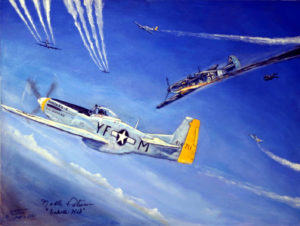 Noble Peterson served with the 358th Squadron of the 355th Fighter Group based at Steeple Morden in Cambridgeshire, England. Noble flew two tours, the first in a P-51B, (Dakota Kid) and the second in a D model, (Dakota Kid II). Known as the Morden Strafers, the 355th became renowned for their low-level attacks on German targets after being released from escort duties.
Noble Peterson served with the 358th Squadron of the 355th Fighter Group based at Steeple Morden in Cambridgeshire, England. Noble flew two tours, the first in a P-51B, (Dakota Kid) and the second in a D model, (Dakota Kid II). Known as the Morden Strafers, the 355th became renowned for their low-level attacks on German targets after being released from escort duties. 

